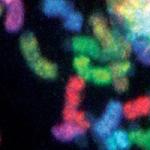
Research Topics
B and T cell differentiation share several common features. B lymphopoiesis takes place in the bone marrow where environmental cues commit multipotent cells to the B lineage. Close to the point of lineage commitment gene rearrangements are initiated at the immunoglobulin heavy chain (IgH) gene locus. Activation of the locus and subsequent V(D)J recombination is regulated in complex ways, and one of our objectives is to understand the molecular mechanisms that underlie this complexity. A parallel pathway operates in the thymus where multipotent cells commit to the T lineage. One important consequence is the activation and recombination of T cell receptor (TCR) b chain genes. The TCRb gene enhancer has been shown to be essential in this process and we have used it to probe this differentiation step.
Biography
Dr. Sen received his Ph.D., degree in chemistry from Columbia University in 1982. He made the transition to molecular biology as a postdoctoral fellow in David Baltimore's laboratory at M.I.T. and the Whitehead Institute. During this stage he developed his current interests in gene regulation. In 1987 Dr. Sen was appointed Assistant Professor in the Department of Biology and Rosenstiel Research Center at Brandies University. He earned tenure in 1991 and was promoted to Professor of Biology in 1998. He moved to his present position as Chief, Laboratory of Cellular and Molecular Biology, National Institute on Aging in 2003.
Selected Publications
- Roy R, Kuo PL, Candia J, Sarantapoulou D, Ubaida-Mohien C, Hernandez D, Kaileh M, Arepalli S, Singh A, Bektas A, Kim J, Moore AZ, Tanaka T, McKelvey J, Zukley L, Nguyen C, Wallace T, Dunn C, Wood W, Piao Y, Coletta C, De S, Sen J, Weng NP, Sen R, Ferrucci L. Epigenetic signature of human immune aging in the GESTALT study. Elife. 2023;12.
- Qiu X, Ma F, Zhao M, Cao Y, Shipp L, Liu A, Dutta A, Singh A, Braikia FZ, De S, Wood WH 3rd, Becker KG, Zhou W, Ji H, Zhao K, Atchison ML, Sen R. Altered 3D chromatin structure permits inversional recombination at the IgH locus. Sci Adv. 2020;6(33):eaaz8850.
- Singh A, Spitzer MH, Joy JP, Kaileh M, Qiu X, Nolan GP, Sen R. Postmitotic G1 phase survivin drives mitogen-independent cell division of B lymphocytes. Proc Natl Acad Sci U S A. 2022;119(18):e2115567119.
- Roy R, Ramamoorthy S, Shapiro BD, Kaileh M, Hernandez D, Sarantopoulou D, Arepalli S, Boller S, Singh A, Bektas A, Kim J, Moore AZ, Tanaka T, McKelvey J, Zukley L, Nguyen C, Wallace T, Dunn C, Wersto R, Wood W, Piao Y, Becker KG, Coletta C, De S, Sen JM, Battle A, Weng NP, Grosschedl R, Ferrucci L, Sen R. DNA methylation signatures reveal that distinct combinations of transcription factors specify human immune cell epigenetic identity. Immunity. 2021;54(11):2465-2480.e5.
- Zhao M, Chauhan P, Sherman CA, Singh A, Kaileh M, Mazan-Mamczarz K, Ji H, Joy J, Nandi S, De S, Zhang Y, Fan J, Becker KG, Loke P, Zhou W, Sen R. NF-κB subunits direct kinetically distinct transcriptional cascades in antigen receptor-activated B cells. Nat Immunol. 2023.
Related Scientific Focus Areas

Molecular Biology and Biochemistry
View additional Principal Investigators in Molecular Biology and Biochemistry




This page was last updated on Friday, August 25, 2023